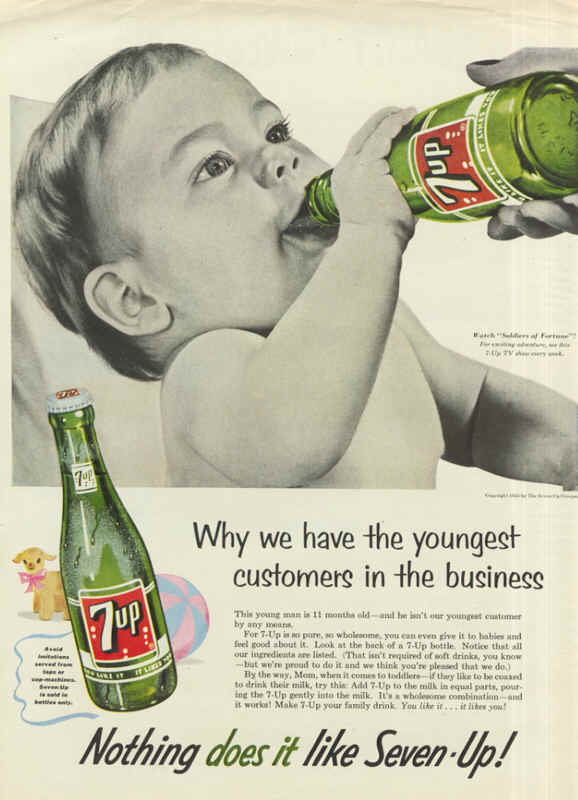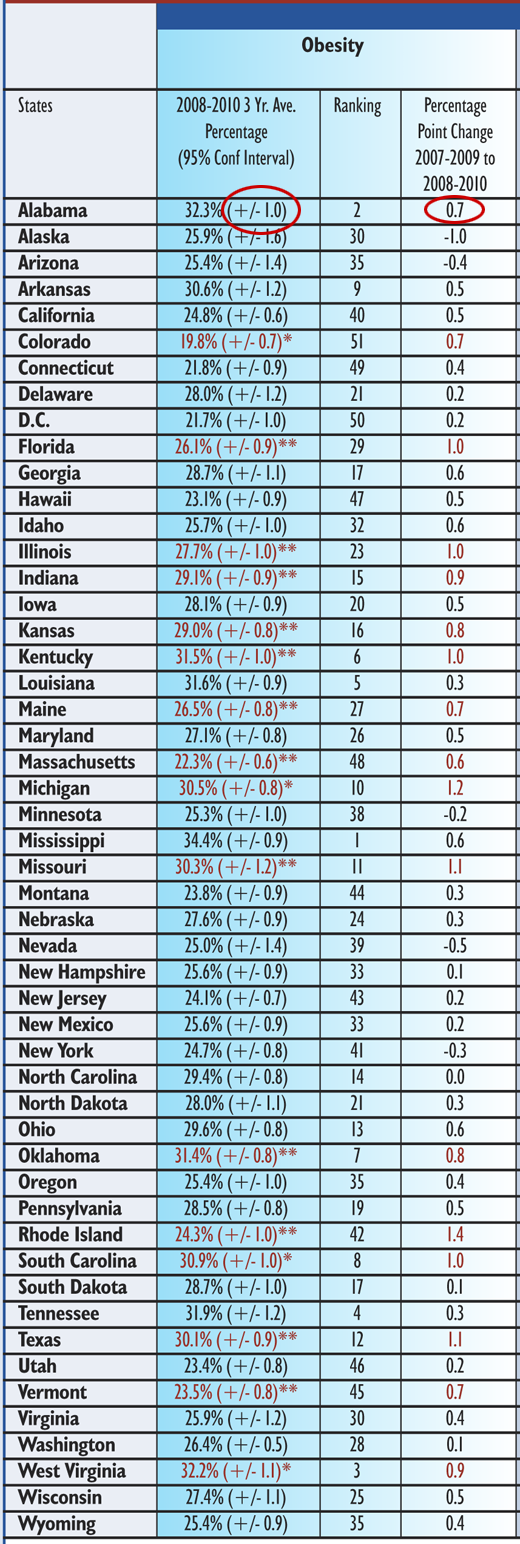Margins of Error
By Lesley | July 14, 2011
Shannon from Fierce Fatties tweeted a link at me earlier this week, to a report from the Robert Wood Johnson Foundation (RWJF) about the obesity scourge. The RWJF, in case you’re unfamiliar with it, is a massive “philanthropic” organization specializing in public health. The organization’s titular founder is, yes, the guy who also brought us Johnson & Johnson, the bazillion-dollar international megacorporation that makes everything from prosthetic joints and blood glucose monitoring systems, to that orange bar of Neutrogena facial soap melting away in your shower, to the tube of KY Jelly you used before you knew there were better lubes out there, to the “No More Tears” baby shampoo your mom washed your little noggin with when you were a wee bairn. You want a list of subsidiary holdings and consumer brands? Wikipedia’s got you covered.
It is not overstating the matter to say that Johnson & Johnson looms over all things healthcare like a towering and inescapable monolith. So it’s little wonder that the Robert Wood Johnson Foundation should rank as the ninth wealthiest charitable organization in the world, outmatched by such notable competition as the J. Paul Getty Trust, the Ford Foundation, the Howard Hughes Medical Institute, and coming in first, the Bill and Melinda Gates Foundation. These are all organizations that deal in billions and billions of dollars, and many of them do quite a bit of good.
This, of course, is not one of those cases.
Why am I am telling you about the background and fiscal resources of this foundation? To make clear that this is one of the most well-funded and highly-respected organizations on the planet. What the RWJF publishes matters. So when they put out an annual report entitled “F as in Fat” on the state of national rampant fattery, people pay attention. The media that shapes our culture and our discourse pay attention. This is the kind of thing that influences news coverage of obesity, which influences how we talk about obesity, which influences what we think we know about fatness and fat people, which ultimately impacts all of us — fat, thin, and bell-curved.
I’m not going to pick apart the whole report, as that would take ages, and frankly, it’s unnecessary — there is so much doublespeak in there that doing so would rapidly become redundant. It frets over rates of diabetes and hypertension seemingly without accounting for the effects of improved diagnosis of such ailments, plus an aging boomer population reaching the stage of life where such problems are hardly unusual. It does usefully identify differences in obesity rates based on gender, race, and class, but doesn’t do much with this information aside from make obvious platitudes about encouraging poor families to eat more salad. You can download the whole thing, for free, as a PDF file to read at your leisure.
For my part, I am just going to draw your attention to a couple of points of interest, to illustrate why we should all be a lot more critical of the panicked rhetoric around obesity paranoia.
For one, the RWJF has a particular interest in the currently trendy social terror of childhood obesity. This is explicitly named as one of their seven program areas. Their report is riddled with dire predictions about the future consequences of so many fat kids, and like most of the media discussing this topic, uses the cultural fear of out-of-control weight gain amongst children to bolster the need for action. And yet, on page 7:
Recent studies have shown that the number of obese children and adolescents may have leveled off since 1999, except among the very heaviest boys ages 6-19, but the rates remain startlingly high.
Here’s a personal memory: in 1999 I was a graduate student in developmental psychology, specializing in the development of media literacy for kids age 6 to 14, particularly as it impacted the body image and self esteem of girls. I spent a truly absurd amount of time analyzing and decoding both teen and women’s magazines, as well as television, film, and news media. I have no recollection of there being half as much “childhood obesity” panic at that time, and as a fat activist, if there was even a whisper of the level of modern day news coverage on this topic, I can assure you I would have picked up on it. And analyzed and written about it.
So. Why weren’t we panicking back in 1999, especially if the rates were “startlingly high”? Why haven’t we seen a decade of ominous warnings? If rates of childhood obesity (except amongst the fattest boychildrens, which represent between 4% and 7% of the total boy population) have been flat for the past twelve years, why are we all talking like the kids are suddenly exploding, when the hard evidence indicates they are not?
Maybe we were too busy demonizing smokers. I have no idea. Honestly. I have used the scapegoat analogy before; part of me thinks we just need to fix on some public ill as the source of our problems, to name it as the blight on our future. But the reality, even according to the Robert Wood Johnson Foundation, would seem to be that the childhood obesity bombshell is a big dud.
The second point to which I would like to draw your attention is a chart. Well, part of a chart. I’ve cropped the interesting bit below; clicking the image links to a full-size image of the whole chart.
This chart tracks the current obesity rates for all fifty states from 2008-2010, ranks them, and then shows the percentage difference — in other words, the rate of change — compared to rates from 2007-2009. I want to point out the rate of change, but also the margin of error, displayed in parentheses next to the current obesity rate in the first column. I even circled them for you.
The margin of error is the amount by which the results may be off, owing to random sampling error. You find it on all sorts of polls, as it influences the quality of the results — a big margin of error means the poll was poorly designed or administered. Usually there is a direct connection between the size of the sample and the margin of error: a sample consisting of 10,000 participants will have a lower margin of error than one only using a sample of 100.
All of the margins of error above are pretty low. But when we compare them to the rate of change, there’s an interesting convergence. Alabama, the second fattest state, shows an obesity rate increase of 0.7% between the 2007-2009 results and the 2008-2010 results. However, the margin of error is plus or minus 1%. If we apply this margin of error to the rate of change, both adding it and subtracting it, we get a different picture. It is statistically feasible that obesity rates in Alabama have not changed at all, or have even decreased by 0.3%. It is also possible that the increase was as much as 1.7%, but even then — it’s a hypothetical increase of less than two percent. Hardly an epidemic.
If this was only true of Alabama, then maybe our hysterical wailing could be forgiven, but no: scroll down the list and you’ll find that nearly all the rates of change are within or near the margins of error.
So where is our missing epidemic? Is it possible it could just be in our heads, some strange mass psychosis brought on by sheer repetition? An acquaintance recently commented to me, upon my mentioning that people my size only comprise roughly 5% of the population: “But it sure seems like people are getting bigger.” It seems that way because that’s what we’ve been told. Even studies that do claim to show a clear increase in fattery over the past few years are illustrating a mere handful of pounds, spread across the entire population, something which can, again, be at least partly explained by my parents’ generation getting older and putting on a bit of weight, as older people often do.
You can disagree with my read on this. That’s fine. I’m just asking you to be critical of the anti-obesity handwringing; do not trust that it’s true simply because you read it on CNN. Read the results and draw your own conclusions. They don’t have to mirror mine, but you should be capable and even inclined to seek out this information for yourself. Because how we think about our bodies and our health affects our whole lives.





 Two Whole Cakes is a blog written by
Two Whole Cakes is a blog written by 


24 Comments